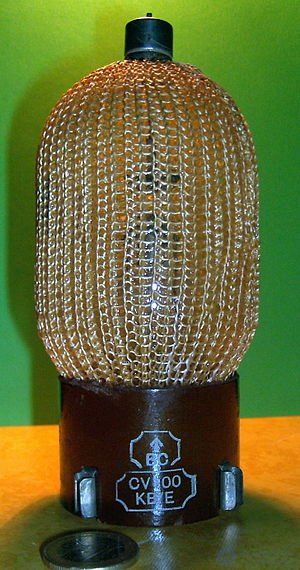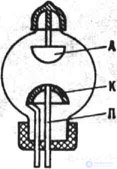Lecture

Trigatron - (from the English. Trigger - starting device, starting signal and (elect) throne ) - a kind of controlled spark gap with a cold cathode for control of high voltages and high currents (usually 10-100 kV, 20-100 kA and up to megaampers).
Trigatron - a cold cathode gas - discharge device auxiliary. electrode controlling the moment of occurrence of a spark discharge in the atmosphere of an inert gas with an increase. pressure (up to several atm). It is used as a switch in devices forming the electric. pulses for the modulation of the microwave coli *** ing (in powerful generator tubes, magnetrons, etc.). See fig.

Trigatron: A - Avod; K - cold cathode; P - managing elekrod. Powerful discharge between A and Kvoznikaet after the breakdown of the auxiliary gap between K and P from a low-power source
The construction of trigatrons is very simple and in many cases their use is the cheapest solution for switching on powerful electrical circuits. They may not have a body and work in air, may have a sealed glass or ceramic body filled with dielectric gas, including under pressure. Trigatron may be filled with a liquid dielectric (for example, mineral oil) to increase the operating voltage. Trigatron can be designed for multiple use (more than 10,000 switching), and can be disposable, collapsing during the first start.
Trigatron has 3 electrodes - 2 massive (main) for passing current and a small control electrode. When the trigatron is off, the voltage between the main electrodes should be less than the breakdown voltage corresponding to the distance between the electrodes and the dielectric applied (air, argon-oxygen mixture, nitrogen, hydrogen or SF6).
To turn on the trigatron, a high-voltage pulse is applied to the control electrode. It ionizes the gas between the control and one of the main electrodes, a spark occurs, which shortens the non-ionized gap between the main electrodes. The spark creates ultraviolet radiation and generates many free electrons in the gap. This quickly leads to electrical breakdown and between the main electrodes arises an electric arc with low resistance. The arc continues until the voltage between the main electrodes becomes less than a certain value.
The control electrode is often located in a cavity in the center of the positive main electrode (anode); the negative electrode (cathode) has no holes.
The electrodes become very hot, as they are exposed to an electric arc, which leads to the gradual evaporation of the electrode material. Some designs trigatrons provide ways to adjust the distance between the electrodes or complete replacement of the electrodes. The main electrodes are usually made of bronze or copper-tungsten compound, obtained by powder metallurgy.
Glass trigatrons are often covered with a protective wavy metal mesh to prevent the pieces of glass from flying when the bulb is broken.
Trigatrons are used in the pulse technique, for example, they were used in the modulators of the first radar to transmit high-power pulses to the magnetrons. Used to control electrical detonators and as dischargers in Marx generators.
Comments
To leave a comment
Radio tubes and ion devices
Terms: Radio tubes and ion devices